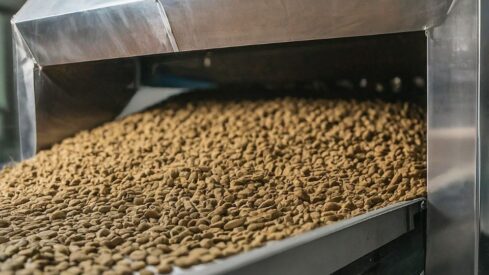How did the pet food and aquaculture production industries fare in 2023?

As American nutrition firm Alltech releases its annual survey, GlobalPETS looks at the most relevant numbers.
Alltech’s Agri-Food Outlook for 2024 concludes that world feed production remained steady in 2023, with a slight decrease of 0.2% to 1.29 billion metric tons due to changing consumption patterns, inflation and geopolitical tensions.
Pet food
The report noted that despite the industry’s continued growth since the pandemic, pet food production slowed to a pace of 0.74%, reaching 34.7 million metric tons.
North America holds the top spot for pet food production in 2023, with 11.3 million metric tons.
Similarly, Latin America’s total tonnage of ingredients used to make pet food rose 3.85% in 2023 to 8.67 million metric tons in 2023 due to higher demand.
Asia Pacific recorded a 2.4% increase, from 2.45 million metric tons in 2022 to 2.51 million in 2023. The report attributed this rise to an increase in the number of pet-owning households in the region.
Some other regions registered a marginal increase. Africa manufactured 820,000 metric tons last year (+1%), while production in the Middle East remained flat at 110,000.
Europe stood out as the only region that saw a decline in pet food production last year, totaling 10.9 million tons in 2023 (-2.7%). According to Alltech, supply-chain disruptions and inflationary pressures are key factors behind this downturn.
Aquaculture
The global aquaculture sector saw a 4.43% decrease in feed tonnage over 2023, down to 52.09 million metric tons in 2023 from 54.51 million in 2022.
The report attributes this decline to a “significant drop” in China’s supply of aqua feed due to lower fish prices, which it claims had a “far-reaching impact.”
Enrico Bachis, Market Research Director at The Marine Ingredients Organization (IFFO), tells GlobalPETS that Chinese consumers’ demand for seafood, particularly of foreign origin, reduced in 2023.
Despite unfavorable weather conditions, Latin America continued its growth trajectory with a 3.9% increase in 2023 to 7.17 million metric tons, owing to strong demand for aqua feed products in the region. Oceania also saw its aquaculture feed tonnage grow by 7.5% in 2023, from 200,000 metric tons in 2022 to 220,000 in 2023.
The Middle East and Africa saw a slight increase in production, with the Middle East growing from 0.97 million metric tons in 2022 to 1.02 million metric tons last year and Africa recording 1.58 million metric tons in 2023, up from 1.50 million the previous year.
North America also saw a marginal increase from 1.75 million metric tons in 2022 to 1.78 million in 2023.
Asia Pacific saw its aqua feed tonnage drop 7.08% to 35.7 million, owing to lower fish prices, difficult weather conditions impacting fish performance and economic conditions decreasing consumer demand for aqua products.
According to the report, Europe again saw a 3% decline to 4.63 million metric tons for the first time in recent years. Diseases found in salmon and trout particularly impacted the market in Norway.
Growing at a lower rate
IFFO’s Market Research Director confirms to GlobalPETS that while the aquaculture sector continues to grow, it is happening at a lower rate than in previous decades.
According to the United Nations Food and Agriculture Organization (FAO), this trend remains the projection for the next decade.
Bachis emphasizes that 2023 was an El Niño year characterized by unusually warm ocean temperatures in the Equatorial Pacific. This natural phenomenon usually causes a drop in the supply of marine ingredients, translating to higher prices for aqua ingredients and lower margins for producers.
“2022 and the beginning of 2023 showed high inflation in major markets such as the EU and the US, so demand for aqua products was weaker there,” he adds.
“The combination of these 2 facts has dented many companies’ performance.”
With the El Niño expected to recede this year, Bachis expects market conditions to “readjust” in 2024. “Both the aquafeed and pet food segments should enjoy a larger availability of marine ingredients in the months and years to come,” he concludes.
